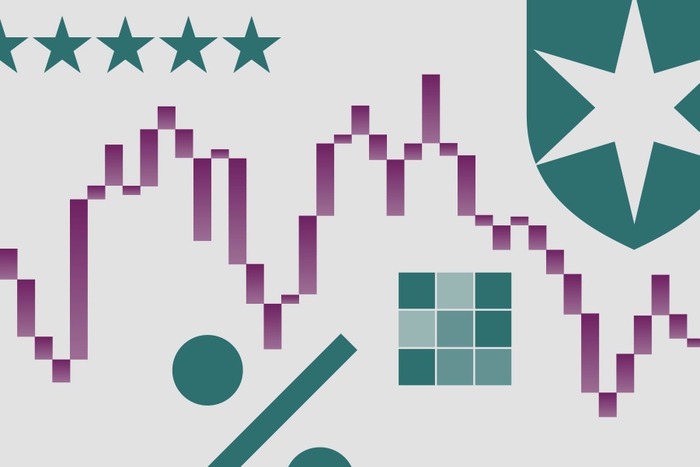Many attribute active stock-pickers’ collective struggles to best index funds to the overall level of efficiency of the market—particularly that for U.S. large-cap stocks. Efficiency in this case is meant to indicate the speed and precision with which market participants incorporate new information (economic news, earnings data, and so on) into stock prices (by selling on bad news, buying on good news). Furthermore, given advances in information technology and the growth in the portion of invest-able assets managed by an increasingly skilled set of professional investment managers, it can be argued the market has become ever-more efficient over time.
But market-cap-weighted indexes’ greatest strength can also be their greatest weakness. By owning “the market,” investors are relying on other market participants to price stocks on their behalf. During long stretches of time investors have done a good job of valuing stocks, but these long horizons have been marked by episodes of mania and panic. The mania most often cited as an example of the drawbacks of owning a cap-weighted index like the S&P 500 outright was the technology bubble. Episodes like this are unavoidable for index investors and create opportunities that have historically been exploited by (some) active managers.
Parting With Price
The concept of “breaking the link with price,” as Research Affiliates’ founder and chairman Rob Arnott would phrase it, when weighting stocks in an index surged in popularity following the bursting of the tech bubble. At the top of the tech craze in 2000, the sector represented about a third of the overall market capitalization of the S&P 500, as valuations for most stocks in the sector reached insane levels. As investors got up off the floor and began dusting themselves off after the crash, the asset manage- ment industry—as it so often does—mobilized to equip them with the weapons they’d need to fight the last war. In the case of exchange-traded funds, this resulted in a boom in new strategic-beta funds, with PowerShares and WisdomTree leading the charge. The common theme among most of these new funds was that the indexes they track do not weight their constituent stocks on the basis of their market cap, but rather some other fundamental measure of their worth, such as book value, cash flow, sales, dividends, or earnings.
Weighting stocks according to their fundamentals as opposed to their going prices made a lot of sense to people who had recently been sold on dot-com stocks on the basis of some ginned-up “valuation” measure related to clicks or eyeballs. However, fundamentally weighted indexes were not the first to decouple their weighting methodology from stock prices; they were preceded by something far simpler equal weighting.
1/n Diversification
If diversification is the only free lunch in investing, then equal weighting (also known as naïve diversification) is a gratis, no-frills noontime meal. As its name implies, it involves assigning an equal weighting to each security in a given selection universe. The math is simple. If n is equal to the number of securities in the selection universe, then each security’s weighting will be equal to 1/n. In the case of Guggenheim S&P 500 Equal Weight ETF (RSP), this means that the fund’s largest holding, Apple AAPL, which has a market cap of $625.3 billion, receives the same initial weighting (1/500 or 0.2%) as its smallest holding, Owens-Illinois OI, which has a market cap of $2.8 billion.
If the goal is diversification, equal weighting does the trick. The approach can avoid issues stemming from single-security-, sector-, and country-level concentration. For example, while the tech sector accounted for about a third of the cap-weighted S&P 500 at the peak of the dot-com bubble, it was never more than 14.5% of the equal-weighted S&P 500. Similarly, in the runup to the global financial crisis, the financials sector swelled to represent 22.4% of the value of the S&P 500. Financials stocks never represented more than 18% of the equal-weighted index.
Speaking strictly in terms of diversification, equal weighting seems like it is a free lunch. But is it one that will leave investors satisfied?
The Case of the S&P 500
As described earlier, equally weighting the constituents of the S&P 500 goes a long way toward reducing
single-security- and sector-level concentration and thus avoiding the ill effects of Mr. Market’s manias. This is illustrated in Exhibit 1. The EW/500 line is a plot of the relative wealth generated by an investment in the equal-weighted S&P 500 versus the cap-weighted S&P 500. When the line is sloping upward, the equal-weighted index is outperforming the cap-weighted index. When the line is sloping downward, the cap-weighted index is outperforming the equal-weighted index. When the line is flat, the two are neck-and-neck.
As you’ll notice, the line slopes steadily downward from the mid-1990s through the turn of the millennium
as the cap-weighted S&P 500 (the growth of which is plotted on the right-hand vertical axis in Exhibit 1) surged higher thanks to expanding multiples in the tech sector. The line’s slope then turns upward beginning in March 2000 as the air began to escape from the balloon. Equal weighting looked silly (along with value strategies and other sensible approaches to stock-picking) on the way up but paid off big as the bubble burst.
.png)
In part 2 of this article, we will continue to explore the case.

















